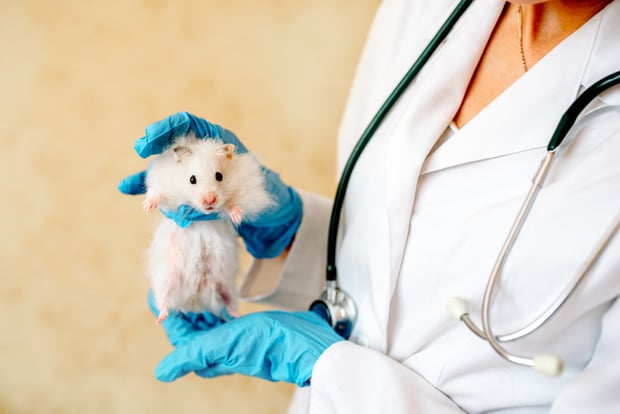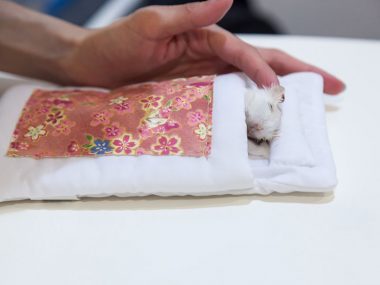Can I tell you a secret? Most hamsters have mites! Yes, I know it’s shocking, but a small mite population is not an issue for a healthy hamster. Health issues occur when the hamster’s systems are overwhelmed by the number of mites on them; the question then becomes when do you treat your hamster for mites? How do you treat them? And what is the best way to protect your hamster from a harmful mite infestation?
Hamster mite infestations are treated with oral Ivermectin. The Ivermectin may be used with other treatment modalities such as topical Amitraz, Spot-on Selamectin, or benzoyl peroxide shampoos. Owners can protect their hamsters by limiting immune system challenges and avoiding exposure risks.
A 2019 study found that 49% to 51% of hamsters have skin conditions; the most common cause is mites. Pathological mite infestations need to be aggressively treated, and the owners educated on how to protect their hamsters from future mite infestations.
Table of Contents
How Do I Get Rid Of Hamster Mites?
One of the first questions hamster owners ask when their veterinarian informs them that their hamster has mites is, “How do I get rid of hamster mites?”. Effective treatment of hamster mites follows three steps:
- Diagnosis.
- Deciding whether to treat the hamster with mites or not.
- Deciding which treatment option will be the safest and most practical choice for your hamster.
How Do Veterinarians Diagnose Hamster Mites?
Diagnosis of hamster mites depends on the findings of:
- Your hamster’s clinical history.
- Physical examination.
- Trichoscopy: a non-invasive, painless procedure that uses a handheld device to capture a magnified image of the hamster’s skin and fur.
- Tape preparations: A transparent adhesive tape collects the hamster’s hair and superficial skin cells for examination under a microscope.
- Skin scrapings: a scalpel blade or razor is used to abrade the skin and collect skin cells from the epidermis.
- Biopsy: a deep tissue sample is collected under local or general anesthesia.
Ethical Questions About Hamster Mite Treatment
Once your veterinarian has diagnosed your hamster with mites, the next step is to determine whether treatment is an ethical choice.
Mite-infested hamsters suffering from concurrent comorbidities (e.g., a severe mite infestation and ulcerating tumors) have a poor prognosis.
Veterinarians will often advise euthanasia for hamsters with a poor prognosis.
The veterinarians have been taught to view euthanasia as an act of mercy and feel that the cost (e.g., monetary, physical, mental, and emotional) of treatment cannot be practically or ethically justified. In their eyes, any attempts to treat the hamster will only extend its suffering.
Hamsters who are young and are relatively healthy apart from the mite infestation are good candidates for treatment and typically have a good prognosis. In these cases, the reward of a long, healthy life justifies the hamster’s temporary distress caused by the treatment procedures.
How Do Veterinarians Treat Hamster Mites?
There is no definitive treatment, and thus different veterinarians will use various medications and treatment protocols.

The treatment options currently available for hamsters with mites include:
- Oral Ivermectin
- Topical Amitraz
- Selenium sulfide shampoos
- Benzoyl peroxide
- Selamectin
Is Ivermectin An Effective Hamster Mite Treatment?
Oral Ivermectin is a popular first-line treatment as it is a relatively safe, low-cost option for treating hamster mites.
In 2001, a Japanese study investigated the use of oral Ivermectin (0.3mg/kg) as a treatment for 56 hamsters with mites. After the first round of treatment, 33 hamsters were cured. The remaining hamsters either relapsed or needed further treatment.
Three months after starting the treatment, 49 (87.5%) hamsters with mites were cured. The 7 hamsters that failed to respond to treatment died during the study.
Can Amitraz Be Used For Hamster Mite Treatment?
Weekly applications with diluted topical Amitraz (100 ppm) can be applied to the hamster’s lesions, i.e., areas where the mites have damaged the skin. Amitraz is typically used in conjunction with oral Ivermectin or as a second line of treatment if the Ivermectin fails to treat the hamster’s mite infestation successfully.
It is crucial to dilute Amitraz correctly, as it is lethal to hamsters in its undiluted form; for this reason, many veterinarians are hesitant about using Amitraz in hamsters.
Signs of Amitraz poisoning in hamsters include:
- Sedation and drowsiness
- Hypothermia, i.e., low body temperature
- Bradycardia, i.e., an abnormally slow heart rate
- Dyspnea, i.e., slow, labored breathing
- Neurological disorders, e.g., seizures
- Death
In cases where Amitraz was used in conjunction with oral Ivermectin, hamsters were cured within 10 weeks, with five treatments performed at 2-week intervals. Most veterinarians recommend an additional two treatments (four weeks) after the last negative skin scraping to protect against relapse.
Are Medicated Shampoos A Safe Hamster Mite Treatment?
Both benzoyl peroxide and selenium sulfide shampoos are frequently used to treat demodicosis (mange caused by mites) in a wide variety of animal species. Benzoyl peroxide shampoos are more commonly used as they have fewer side effects than sulfur-containing shampoos.
Benzoyl peroxide shampoos have antimicrobial action and are commonly used for flushing hair follicles. The benzoyl peroxide in medicated shampoos is metabolized in the skin as benzoic acid, an oxidizing agent that causes catastrophic rupture of bacterial membranes.
Although benzoyl peroxide shampoos are effective in treating mites, their use in hamsters is controversial.
Water and hamsters are not a good mix! Bathing a hamster can cause:
- Extreme stress
- Hypothermia
- Pneumonia
- Wet tail disease
- Physiological shock and potentially death
Using medicated shampoos on hamsters should be a last resort, as the treatment may be more dangerous for the hamster than the mite infestation!
When Is Selamectin Used For Hamster Mite Treatments?
Selamectin is a topical spot-on licensed for use in dogs and cats. Due to the shortage of hamster specific-medications, veterinarians have begun experimenting with medications formulated for use in other animal species.
Veterinarians have found that Selamectin is effective for hamsters infected with Ornithonyssus bacoti (i.e., tropical rat mites).
Merck’s Veterinary Manual recommends that hamsters with pathological mite infestations be treated with a combination of 1% selenium sulfide shampoos and a once-off application of topical Selamectin (15mg/kg of body weight).
If hamsters fail to respond to treatment, then it is likely that an underlying disease was responsible for the pathological mite infestation and resultant mange. Hamsters with resistant mite infestations have a poor prognosis, and most will die within three months of the symptoms first appearing.
What Do Hamster Mites Look Like?
Most mites are smaller than 0,0197″ (0.5 mm) and thus are challenging to spot without the aid of a microscope. A microscope enables veterinarians to magnify and see the mite’s identifying features.
It is essential that veterinarians correctly diagnose the mite species that infected the hamster to design an effective treatment protocol. Hamsters can be infected with two or more mite species because mites live on different parts of the hamster’s body.
The University of Missouri has excellent pictures of what the Demodex spp. hamster mites look like under a microscope.
Are Hamster Ear Mites Different From Other Hamster Mites?
Many people assume that Hamster Ear Mites are typical Demodex spp. mites that have decided to make their home in the hamster’s ears. However, this assumption is not true.

Different mite species inhabit species-specific parts of the hamster; thus, the location of the mite is an effective diagnostic tool that veterinarians utilize in determining what type of hamster mite they are treating.
Hamster mites by body location:
- Demodex criceti and Demodex aurati are the most common mites found on the hamster’s body; in rare cases, hamsters may be infected with tropical rat mites.
- Hamster ear mites belong to the family Notoedres sp.
- The scientific name for hamster nasal mites is Spleorodens clethrionomys.
How To Tell If You Hamster Has Mites?
“How do I know if my hamster has mites?” this is a good question that many owners ask. Unfortunately, it is almost impossible to tell if a healthy hamster has mites; most owners only realize their hamster has a mite problem when the hamster starts showing signs of mange.
Symptoms of mange in hamsters include:
- Alopecia (i.e., hair loss), during the early stages, the hair loss is most noticeable on the hamster’s back and hindquarters.
- Dry, peeling, and crusty skin.
- Skin lesions, i.e., areas where the skin has cracked or ulcerated.
- Secondary infections are prevalent in hamsters with mange.
Why Do Hamsters Gets Mites?
The most common way the hamsters become infested with mites is through exposure to other hamsters with mites, e.g., a pup can get mites from his mother if she has mites.
Although it is less common than a hamster-to-hamster mode of transmission, a hamster may also become infected with mites because of:
- Mite-infested bedding.
- Poor cage hygiene.
- Their owner handled a mite-infested hamster before picking up the hamster.
- Exposure to other animal species with mites, e.g., rats infected with tropical rat mites.
A hamster’s immune system plays a vital role in keeping a hamster’s resident mite population under control; you won’t notice any mite-related issues in a healthy hamster. The hamster’s immune system ensures that the mite population doesn’t grow too big.
Any factor that challenges the hamster’s immune system could cause the mite population to exceed the pathology threshold; uncontrolled mite populations are why hamsters develop mange.
Risk factors associated with the development of mange in hamsters with mites:
- Stress
- Old age
- Inadequate nutrition
- Hyperadrenocorticism
- Concurrent neoplasia, e.g., cancer, tumors
- Systemic disease and infection
- Chronic renal disease
Will Hamster Mites Go Away Without Treatment?
Hamster mites will not go away without medical treatment. However, despite a mite infestation, you can help keep your hamster healthy by ensuring they are kept in a low-stress environment, given a high-quality, balanced diet and good cage hygiene is maintained.
Can Humans Get Mites From Hamsters?
The most common mites found on hamsters are two species of Demodex spp. mites. These mites are highly host-specific and thus are not readily transferred between animal species.
Neither Demodex aurati nor Demodex criceti pose a significant threat to humans. Although the mites may transfer from the hamster to the human handler, the infestation is temporary. Humans are not viable hosts for either of the two Demodex species that commonly infect hamsters.
Can Hamster Mites Live In The Carpets?
Demodex aurati and Demodex criceti rarely survive when parted from their hamster host. The Centre For Food Security And Public Health states that most Demodex spp. mites are quickly killed when separated from the host animal.
The Demodex spp. mites become desiccated and die when exposed to temperatures of 68 F° (20°C) and 40% humidity for more than 60 minutes.
However, other mite species like tropical rat mites are hardier and can survive for up to 6-weeks without a primary host, i.e., this mite species can live in your carpets.
Regardless of the type of mite infesting your hamster, it is a wise precaution to clean your carpets to prevent resident mites, re-infecting your hamster.
How To Prevent Your Hamster Getting Mites?
It is only possible to prevent your hamster from getting mites if they don’t already have a mite infestation.
This statement may seem self-evident but remember it is almost impossible to identify a hamster with mites unless they have started showing clinical signs of mange. Your hamster might have picked up mites before you brought them home if their mother or cage mates had mites.
To prevent a non-infected hamster from getting mites:
- Don’t expose your hamster to other hamsters. Remember, even healthy hamsters can have a “hidden” mite infestation.
- Use clean, mite-free bedding from a reputable source.
- Practice good cage hygiene.
- Ask your veterinarian how to sterilize a cage and room if your previous hamster had mange.
- Always isolate hamsters with mange and follow your veterinarian’s advice on following effective quarantine procedures.
Conclusion
It is not a welcome thought to think that most hamsters have mites, but mites rarely cause an issue for healthy hamsters. A hamster with a working immune system can tolerate a small resident mite population without a problem.
However, any factor which compromises the hamster’s immune system can lead to a population explosion in the hamster’s resident mite population. The hamster will develop mange once the mite population has exceeded the pathology threshold. Mange is extraordinarily uncomfortable and, if left untreated, can be lethal to affected hamsters.
Mite-infested hamsters are typically treated with oral Ivermectin, which may be combined with topical Amitraz, spot-on Selamectin, and medicated shampoos.
The best way to protect:
- An infected hamster is by ensuring they don’t face any unnecessary immune challenges.
- A non-infected hamster is by avoiding exposure risks, i.e., don’t let them come in contact with unknown hamsters and always use clean mite-free bedding.
Resources
https://www.ncbi.nlm.nih.gov/pmc/articles/PMC3999645/
https://www.veterinary-practice.com/article/demodicosis-in-the-hamster
https://veteriankey.com/diagnostic-techniques/
https://www.ncbi.nlm.nih.gov/pmc/articles/PMC7158296/
https://www.entomoljournal.com/archives/2021/vol9issue4/PartE/8-5-317-105.pdf
https://kitaplar.ankara.edu.tr/xmlui/bitstream/handle/20.500.12575/59284/11569.pdf?sequence=1&isAllowed=y
https://www.vin.com/apputil/content/defaultadv1.aspx?id=3852175&pid=11181
https://www.researchgate.net/publication/331279564_Companion_hamsters_with_dermatological_lesions_a_retrospective_study_of_102_cases_at_two_university_veterinary_teaching_hospitals_1985-2018
https://www.criver.com/sites/default/files/resources/FurSkinandEarMitesTechnicalSheet.pdf
https://www.sciencedirect.com/book/9780323376518/small-animal-dermatology






